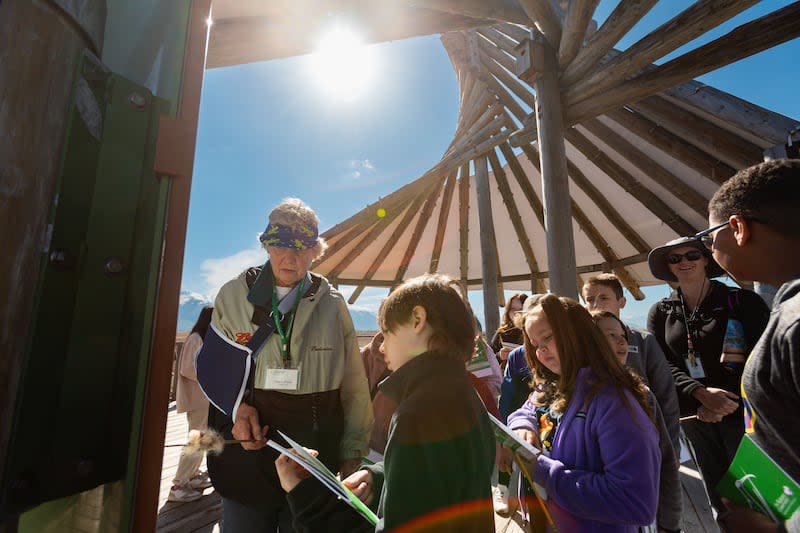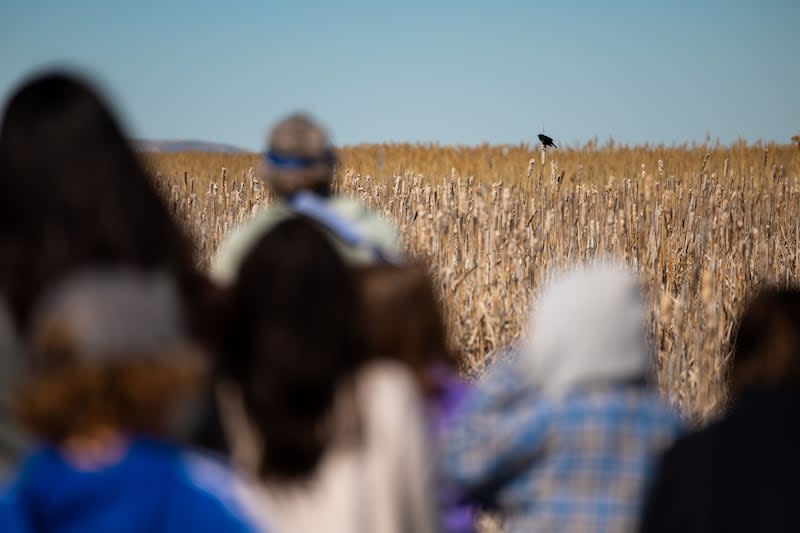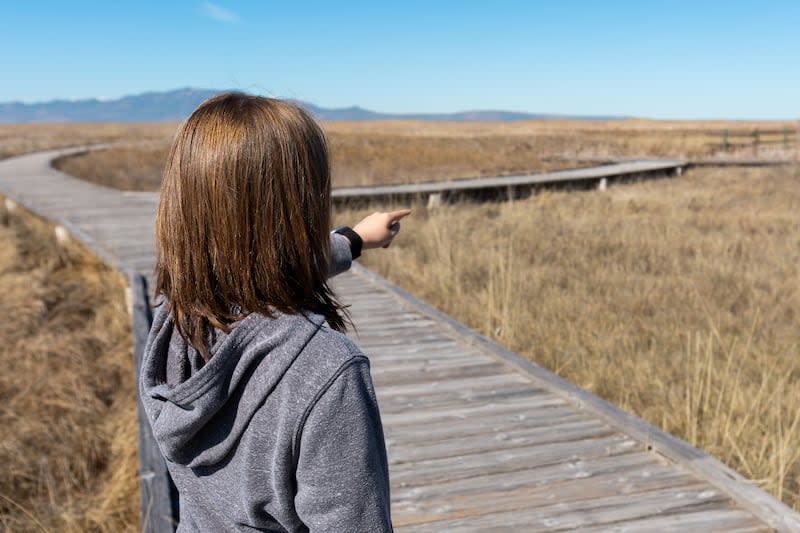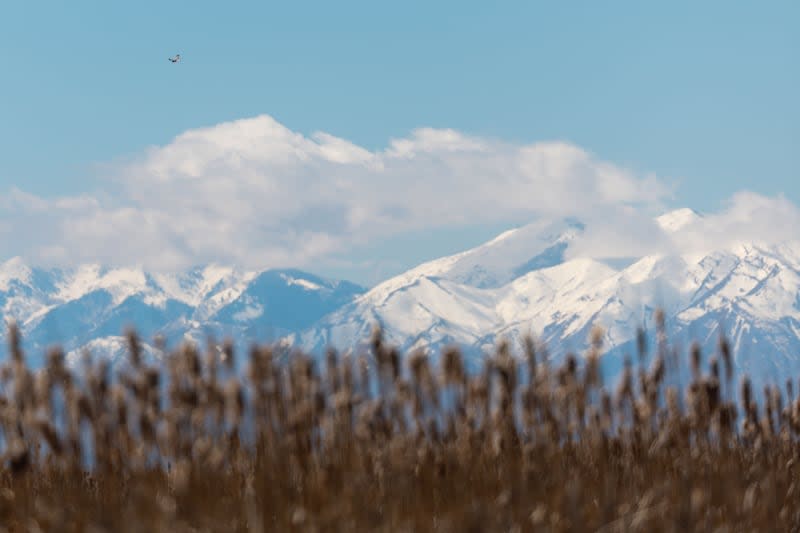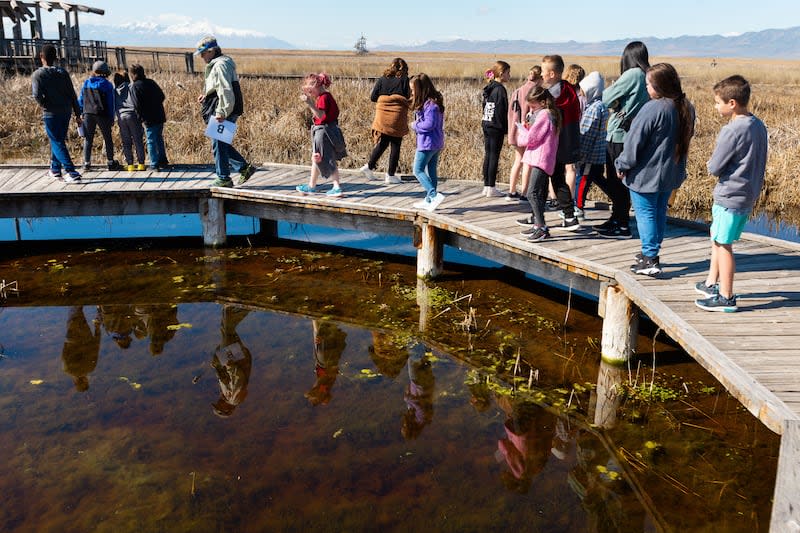Shorelands Preserve highlights recreation at Great Salt Lake
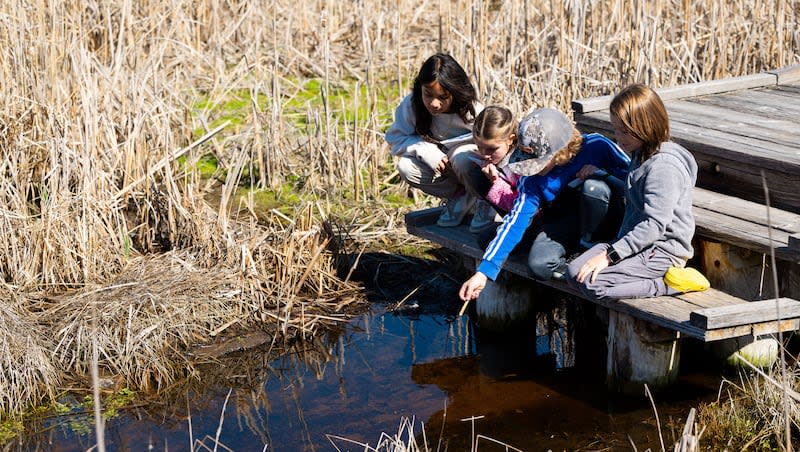

Editor’s note: This article is published through the Great Salt Lake Collaborative, a solutions journalism initiative that partners news, education and media organizations to help inform people about the plight of the Great Salt Lake — and what can be done to make a difference before it is too late. Read all of our stories at greatsaltlakenews.org.
Leave it to a couple of 10-year-olds to find some strands from a three-square bulrush commonly found in salt marshes and wetlands to engage in a pretend sword fight.
The yellow strands that get their name from its unique three sides that look square are plentiful enough to fortify an army of children engaged in pretend combat. Or not.
“We don’t fight with them. These are plants of peace,” Andrea Nelson told them gently.
Saramad Ghaderi, also 10, found his calling at a mossy pond where years ago, a young student thought the green covering over the pond was a carpet of sorts, walking right in to get soaked and covered with mud.
Ghaderi wanted to duplicate her experience and with the chants of his fellow students, “Get in!” bellowing behind him, he looked to eagerly take the dive.
Again, Nelson reminded the group there would not be any pond diving — at least not today.
Later, a group of the excited students fell into silence as they listened to the extremely loud chorus of singing frogs. Eagerly, they strained to see them, but alas, the performers are quite tiny and hard to spot.
This is the fun that is offered at the Great Salt Lake Shorelands Preserve on the eastern shore of the Great Salt Lake, spanning 4,500 sprawling acres of bogs and birds and frogs and a mostly untouched piece of nature that is an increasingly rare occurrence along the rapidly growing Wasatch Front. The Wasatch Front is the most densely populated area in Utah, home to more than 80% of the state’s residents, with an estimated two million people packed into a narrow strip of land between the lake and the mountains.
The preserve is operated under the stewardship of The Nature Conservancy, a nonprofit organization that seeks to set aside land for people to enjoy now and for their descendants to enjoy later. It has forged a partnership with the Utah State University Botanical Center to promote and operate the preserve in a thriving relationship that makes it stronger.
Nelson is a co-coordinator of the popular Wings and Waters Program that connects about 2,000 fourth graders each year to the preserve as part of their science curriculum. The conservancy, along with USU, recruits volunteers and support through naturalist guides and stewards of the land.
On Thursday, a group of 65 students from Sprucewood Elementary School in Sandy took a guided tour along the boardwalk made from old railroad trestles from the Union Pacific causeway. They stopped and pondered the educational signs along the way with pictures and brief descriptions about the birds that use the preserve as a vital place for nesting, feeding, breeding and of course, flying.
As an example, the Wilson’s phalarope is a frequent flier to the Great Salt Lake each year — home to 90% of the bird’s entire global population. During its time in the marshes, it doubles its body weight before making a 4,500 mile nonstop journey for its winter home in Argentina.
The school kids tried to imagine that, as well as the fact that the Great Salt Lake area is home to the largest nesting population of the white-faced ibis. The lake and shoreland is along the Pacific Flyway, hosting hundreds of species of birds and millions of them each year.
Since its inception, the Wings and Water Program in 2006 has introduced more than 25,000 schoolchildren to the wonders of the preserve.
It serves multiple purposes. It’s educational, it’s recreational — children get to scamper about in the outdoor theater of nature — and appreciate something that may not be right on their doorstep, such as those children on Thursday from Sandy.
“There’s this big, diverse, unique lake and an ecosystem that may be not right next door, but they begin to think about it and you know, visit and learn and steward it — that sort of thing,” Nelson said. “For a lot of students and their families, it may be their first introduction. We see it as a way for them to create a lasting relationship with it.”
Amid the schoolchildren, adults and their own children were independently taking in the wonders. They paused to take photos, read the informational signs and took advantage of the rustic, beautifully designed pavilion and were able to enjoy some quality time outdoors.
As part of the agreement that was part of the construction of the new West Davis Corridor, there is a 10-mile trail for walking, biking, jogging and wetlands gazing adjacent to the wetlands
There is a quiet sort of peace out here, despite excited, talkative children pointing here and there and teasing each other.
“It’s a zen moment for many people,” she said. “A place to connect.”
This is one of those places that makes you realize how big nature is and how small we are.
The birds adapt, the frogs, bats and squirrels and all sorts of wildlife find refuge and are likely relishing in the last two years that have delivered water to the wetlands to help them get a bit of TLC, which is vital for this ecosystem.
Volunteer Brad Timothy led a group of students and had them enthralled with a color-coded piece of the boardwalk marked with round tiles. He had each of his group stand on the white tiles for the month they were born. The tiles expanded according to the time of the year. The fewer the tiles, the less sunlight.
He asked one boy what was so special about April, since two of the other color-coded tiles expanded greatly. One denoted Wilson’s phalarope and its presence there and the other, the red ones, represented the American avocet, a long-billed, long-legged colorful bird.
The boy knew the answer immediately.
“It’s the month I was born!”
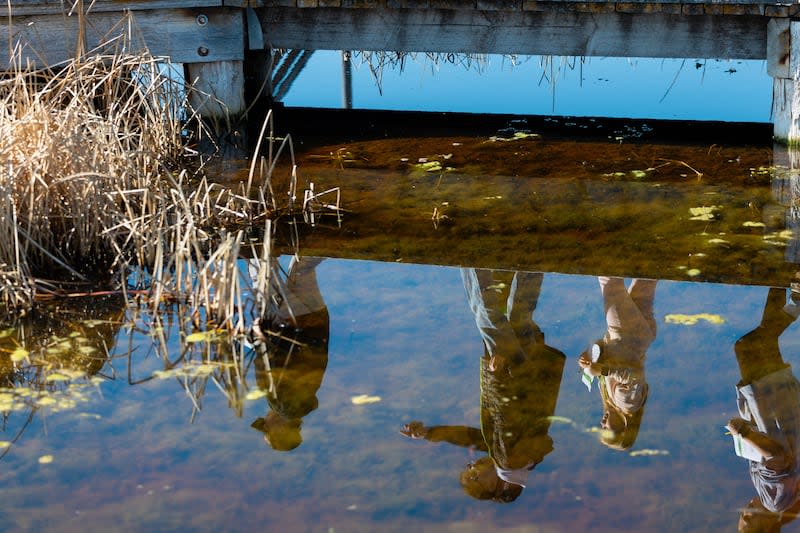
Timothy is an old pro when it comes to wetlands. He’s volunteered for years and is at ease with the children.
He gestures to a pair of marsh wrens and the children immediately fell silent to get a good look.
Earlier, he told the Deseret News he comes out to the preserve each day. On Tuesday, when he showed up, he said his vehicle had the only Utah license plate in the parking lot.
“People are coming from all over to see this, from all over the world, all over the country,” he said. “The kids for the most part are very interested in this. They connect with nature and they’re not on their phones.”
He urged the children to tell their classmates, their friends and their family about what this place has to offer.
“It is something worth being protected. If you help, you can take care of it.”
A trio of girls, early into the field trip, were mesmerized by the cattails.
“It’s cool with all the plants and animals,” said Lola Henlin.
Mazie Morgan and Ca’liyah Whitmore said it was a fun trip, with the sun and the birds and the mysterious marshes.
One girl excitedly proclaimed the fluff from the cattails must contain “500 million seeds” and she wanted to have the fluff planted all over her tiny frame.
Her grin said it all.
